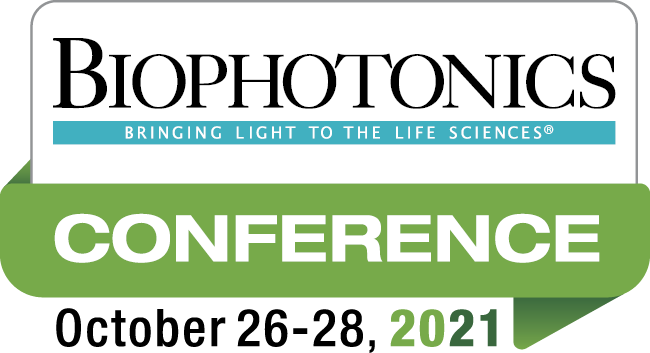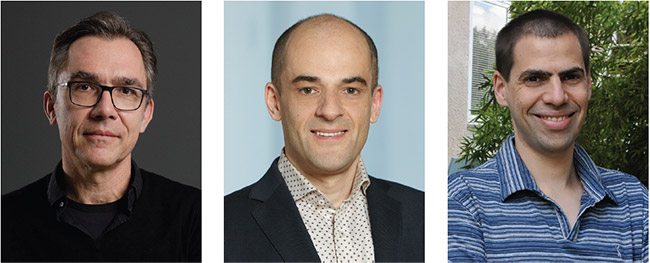Full company details
Photonics Media
A Laurin Publishing Co.
 PO Box 4949
PO Box 4949
Pittsfield, MA 01202-4949
United States
Phone: +1 413-499-0514
Fax: +1 413-442-3180
The BioPhotonics Conference
BioPhotonics
Sep/Oct 2021Join industry colleagues to discover the latest advancements in biomedical imaging, medical lasers, and more in a three-day online conference in October.
Photonics Media will host the first-ever
BioPhotonics Conference online Oct. 26-28. Experts in microscopy, spectroscopy, OCT, flow cytometry, and medical lasers will present on topics such as the detection of cancer and viruses, the analysis of blood and tissue, and diagnostics that enable the imaging of brain functioning.
Attendees will be able to view more than 25 sessions starting Tuesday morning, Oct. 26.
Keynote speakers
Keynote speakers representing industry and academia will deliver sessions that offer insights into preeminent imaging technologies and potential clinical therapeutics.
In “Clinical Multicontrast Spectroscopy,” Jürgen Popp — scientific director of the Leibniz Institute of Photonic Technology in Jena, Germany, and editor of the peer-reviewed Journal of Biophotonics — will highlight recent efforts to implement multicontrast spectroscopy in combination with AI-based analysis for improved clinical diagnoses leading to personalized therapies. Popp will also discuss the use of Raman spectroscopy in routine clinical applications.
“Quantum-Enhanced Superresolution Confocal Microscopy,” from Dan Oron of the Weizmann Institute of Science, and “Advanced Optoacoustic and Fluorescence Techniques for Noninvasive Scalable Imaging of Mammalian Brain,” from Daniel Razansky of the University of Zürich and ETH Zürich round out the keynote sessions.

(From left) Jürgen Popp, Daniel Razansky, and Dan Oron will keynote the inaugural BioPhotonics Conference. The virtual event will run Oct. 26-28 and is free to attend.
Breakthroughs in imaging
In his presentation “LED-Based Photoacoustic Imaging: From Bench to Bedside,” Cyberdyne Inc.’s Mithun Kuniyil Ajith Singh discusses the reasons that LED arrays are becoming increasingly popular for use in biomedical photoacoustic imaging. And in “Novel Amplification-Free Methods to Detect Viruses,” Laura Fabris, professor of materials science and engineering at Rutgers University, shares her group’s results on the implementation of surface-enhanced Raman spectroscopy probes for identifying and quantifying viral RNA, and for monitoring the onset of mutations.
Deep learning, automation
Deep learning, automated systems, and AI will be featured in multiple presentations that cover microscopy, histopathology, and biomedical sensing.
Aydogan Ozcan — the Chancellor’s Professor and the Volgenau Chair for Engineering Innovation at UCLA, where he leads the Bio- and Nano-Photonics Laboratory — will provide a detailed look at deep learning, which holds numerous opportunities for revolutionizing image formation, reconstruction, and sensing fields. In “Deep Learning for Biomedical Imaging,” Ozcan provides an overview of recent work on the use of deep neural networks in advancing computational microscopy and sensing systems, and he covers the biomedical applications of deep learning.
“Reshaping Histopathology with Deep Learning” and “Autofocus Optimization for Automating Microscopy Systems” are among additional presentations covering the capabilities of deep learning and automation in biophotonics applications.
Industry, academic leaders
The
BioPhotonics Conference gives attendees the chance to join industry and academic leaders from across the biophotonics and biomedical imaging space.
Speakers from Olympus Corp., TOPTICA Photonics, Invetech, Optics Balzers, Biolase, and other companies offer their perspectives on innovations in technology. Their presentation topics range from optical thin-film coatings to dental lasers, and from the rapid detection of COVID-19 to high-end optical filters.
Presenters from renowned institutions around the world will also lead sessions, and time will be allotted for questions at the conclusion of each talk. Thought leaders from ETH Zürich’s Institute of Biomedical Engineering, Duke University’s Biomedical Interferometry Optics and Spectroscopy (BIOS) lab, POSTECH’s Bio Optics and Acoustics Laboratory, and Harvard Medical School’s Dana Farber Cancer Institute will present, among others.
Registration for the
BioPhotonics Conference is free. More information is available at
www.photonics.com/bpc2021.
|
MICROSCOPY
|
KEYNOTE:
Quantum-Enhanced Superresolution Confocal Microscopy
Dan Oron, Weizmann Institute of Science
|
Pushing the Imaging Speed Limit in Multiplexed Microscopy
Kevin Tsia, University of Hong Kong
|
Femtosecond Lasers for High-Resolution Bone Tissue Surgery
Laura Gemini, ALPhANOV
|
High-End Optical Filters: Challenges and Solutions to Optimizing Fluorescence Analysis
Christian Katzer, Materion Balzers Optics
|
Deep Learning Advances Optical Microscopy
Aydogan Ozcan, University of California, Los Angeles
|
Quantitative Analysis of Intact Organs Using Adaptive Light-Sheet Microscopy
Alon Greenbaum, North Carolina State University
|
In Vivo Label-Free Multimodal Optical Imaging of Mouse Brain
Dan Fu, University of Washington
|
Soft, Biocompatible Optoelectronic Neural Interfaces
John A. Rogers, Northwestern University
|
Reshaping Histopathology with Deep Learning
Yair Rivenson, Pictor Labs
|
SPECTROSCOPY
|
KEYNOTE:
Clinical Multicontrast Spectroscopy
Jürgen Popp, Leibniz Institute of Photonic Technology
|
Novel Amplification-Free Methods to Detect Viruses
Laura Fabris, Rutgers University
|
Neuroscience in the Everyday World
Meryem Ayse Yücel, Boston University
|
SESORS for Preclinical Imaging of Cancer
Fay Nicolson, Harvard University
|
Low-Cost, Compact Protein Biomarker Sensors Based on Lens-Free Microscopy
Euan McLeod, University of Arizona
|
Expanding Capabilities with Optimized NIR Confocal Imaging
James Lopez, Olympus Corp.
|
Raman Spectroscopy Rapidly Detects COVID-19
Derek Guenther, Ocean Insight
|
Point-of-Care Functional Optical Spectroscopy Platform for Precision Quantification of In Vivo Tumor
Metabolism and Vasculature in Small Animals
Caigang Zhu, University of Kentucky
|
Clinical Deployment of a Platform Technology for Spectroscopic Identification of Diseases
Frédéric Leblond, Polytechnique Montréal
|
|
IMAGING
|
KEYNOTE:
Advanced Optoacoustic and Fluorescence Techniques for Noninvasive Scalable Imaging
of Mammalian Brain
Daniel Razansky, University of Zürich and ETH Zürich
|
Multimodal Imaging: Photoacoustic Imaging and More
Chulhong Kim, Pohang University of Science and Technology (POSTECH)
|
Full-Field Optical Coherence Tomography
Egidijus Auksorius, Center for Physical Sciences and Technology
|
LED-Based Photoacoustic Imaging: From Bench to Bedside
Mithun Kuniyil Ajith Singh, Cyberdyne Inc.
|
Dual-Axis OCT for Diagnosis
Evan Jelly, Duke University
|
Advancing Translational OCT to Assess Eardrum Dynamics and Middle Ear Infections
Jenny Won, University of Illinois
|
Flow Cytometry: Come a Long Way, Much Left to Do
Giacomo Vacca, Kinetic River
|
Lasers in Dentistry: Past, Present, and Future
William E. Brown, BIOLASE
|
|